지금의 기록이 미래의 자산이 된다.
Today's records become tomorrow's assets.-
Google Search Console에 GitHub 블로그 등록하기
- 1단계 : Google Search Console에 URL 등록
- 2단계 : HTML 파일 github.io 폴더안에 추가
- 3단계 : sitemap.xml 파일
- 4단계 : robots.txt 파일 생성
- 추가) rss 등록
- Reference
-
Google 서치 콘솔(구글 웹마스터 도구)을 사용해 내 사이트의 검색 트래픽 및 실적을 측정하고, 문제를 해결하며, Google 검색결과에서 내 사이트가 돋보이게 할 수 있다.
-
Jekyll테마에서 구글 검색엔진에 포스트 글들이 검색되도록 설정해보려고 한다.
사전에 Google 계정을 만들어야 한다.
1단계 : Google Search Console에 URL 등록
- Google 서치 콘솔(Search Console)에 접속한다.
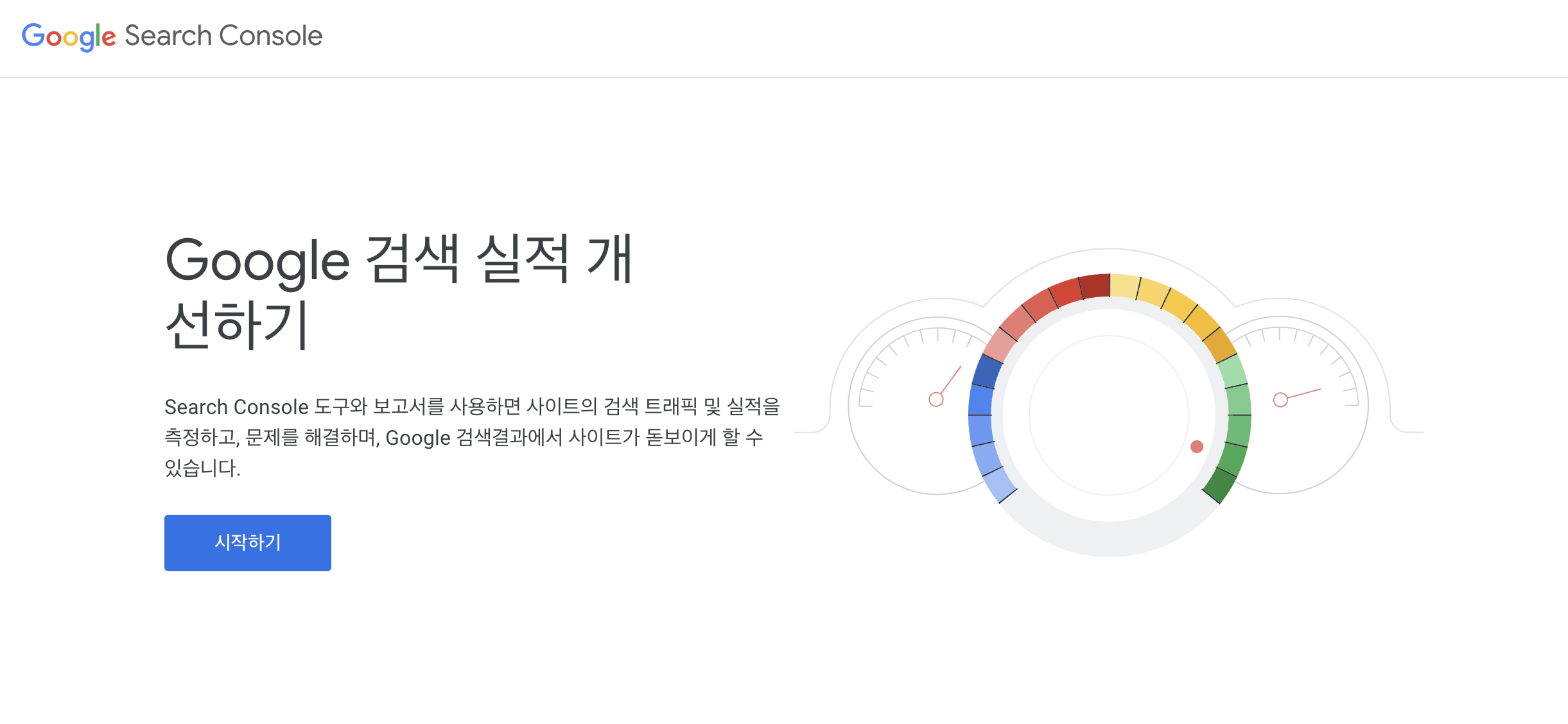
- (Google 계정으로 로그인하고)
시작하기버튼을 클릭한다.
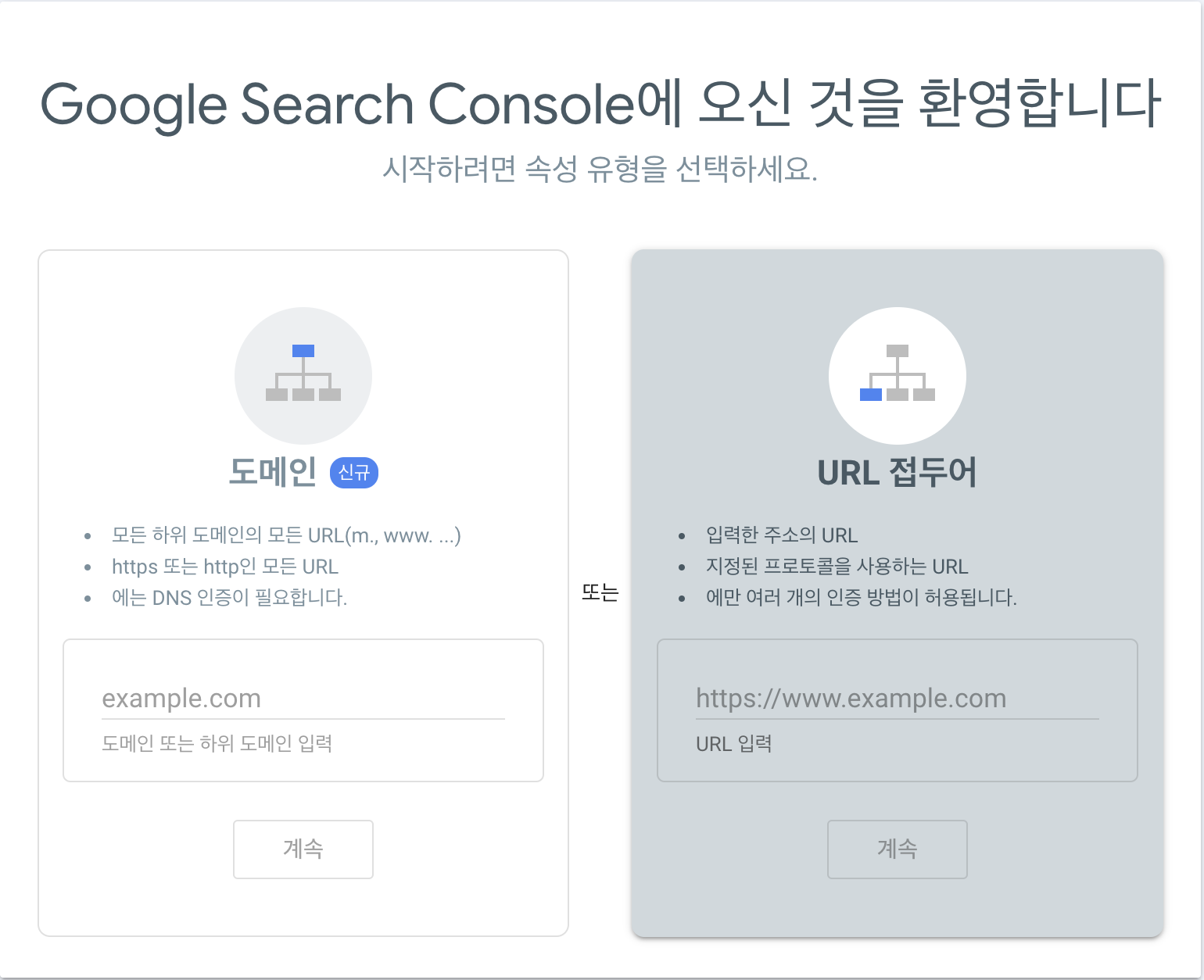
-
속성 유형 선택에서 URL 접두어 유형에서 URL 입력 칸에 내 사이트 도메인(URL)주소를 입력하고 계속 버튼을 클릭한다.
-
여기서 나는
https://devfancy.github.io/을 입력했다.
2단계 : HTML 파일 github.io 폴더안에 추가
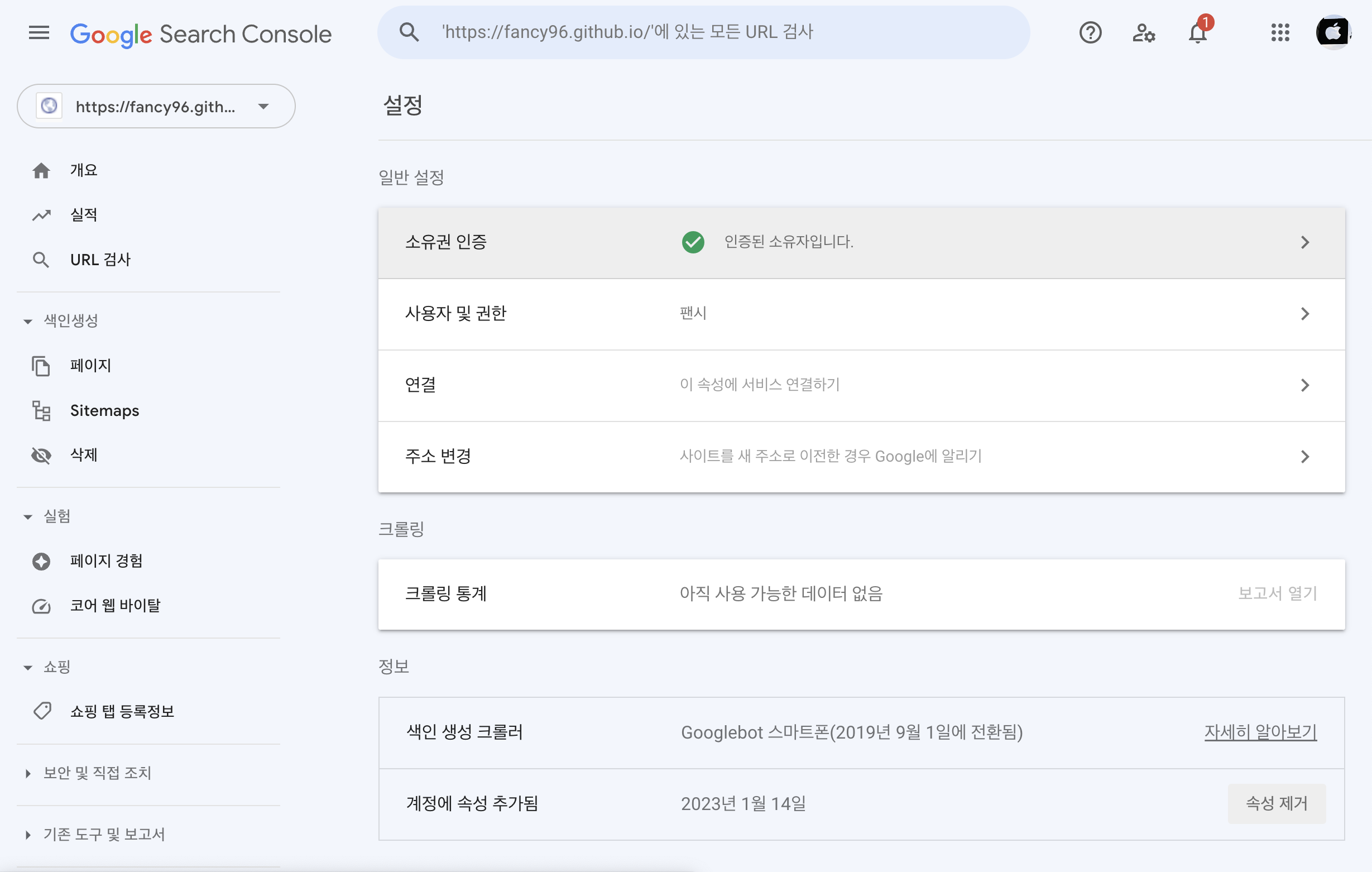
- 왼쪽 아래에 설정을 클릭한 다음 우측에 있는 소유권 인증을 클릭한다.
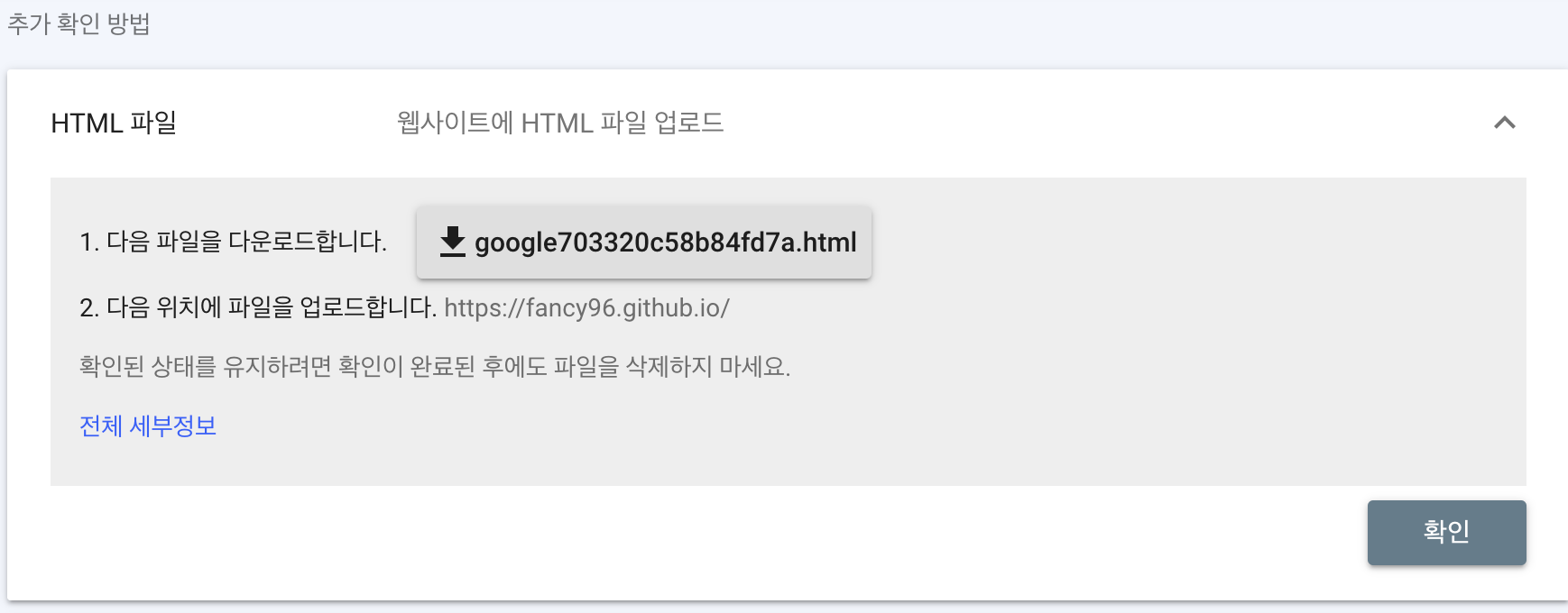
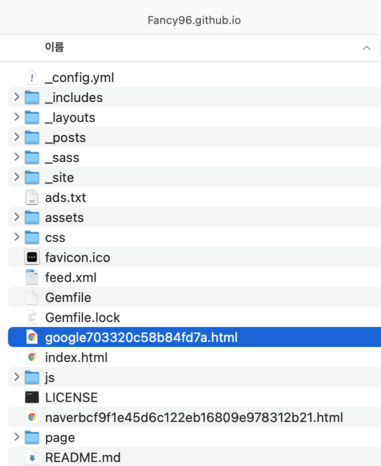
- 여기서
HTML 파일을 클릭한 후 아래의google~~~.html파일을 다운로드 하고 내 github.io 폴더안에 추가한다.

- 그리고 몇분정도 지나고 새로고침을 하면, “확인이 완료되었습니다.” 라는 문구가 뜨게 된다.
3단계 : sitemap.xml 파일
-
Sitemap.xml(사이트 맵) 파일은 검색 엔진 크롤링 로봇에게 웹 사이트에서 크롤링 해야 할 URL 을 전달한다.
-
사이트 맵을 지원하는 검색 엔진은 이 정보를 사용하여 웹 사이트 크롤링을 보다 효율적으로 할 수 있게 된다.
sitemap 자동 생성
- _config.yml 파일의 plugins에 아래 코드와 같이
jekyll-sitemap이 적혀져 있으면, github 가 자동으로 sitemap.xml 을 생성해주므로 별도의 작업을 안해도 된다.
... plugins: - jekyll-paginate - jekyll-sitemap ...sitemap 등록(수동 생성 기준)
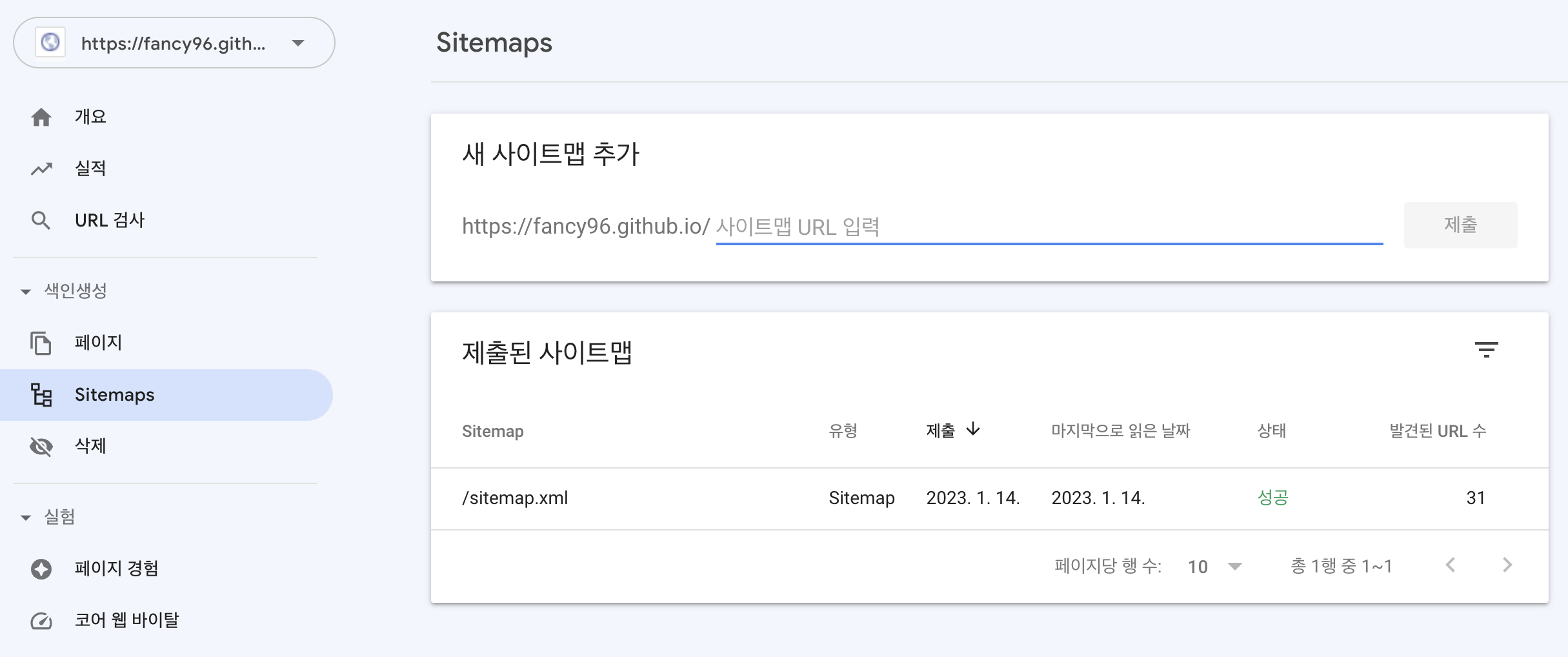
- 왼쪽 Sitemaps 클릭하여 새 사이트 URL 입력칸에
sitemap.xml을 입력한 후에 제출 버튼을 클릭하면 성공이라는 표시가 뜨게 된다.
4단계 : robots.txt 파일 생성
-
Robots.txt는 검색의 크롤링 로봇이 웹에 접근할 때 로봇이 지켜야하는 규칙과 사이트맵(sitemap) 파일의 위치를 알려주는 역할을 하는 파일이다. -
Robots.txt 파일을 설정하지 않으면 구글 검색엔진 로봇들이 웹 사이트에서 찾을 수 있는 모든 정보를 크롤링하여 검색엔진 검색결과에 노출시키기 때문에, 내 특정 페이지가 검색엔진에 노출되지 않으려면 robots.txt 파일을 설정하여 이를 제어할 수 있다.
-
Robots.txt 파일 역시 내 github.io 폴더안에(루트 폴더)에 위치시켰다(sitemap.xml 위치와 동일)
-
나는 다음과 같이 robotx.txt를 설정하였다.
User-agent: * Allow: / Sitemap: http://devfancy.github.io/sitemap.xml-
이
robots.txt파일의 의미는 “모든 사용자 에이전트는 전체 사이트를 크롤링할 수 있다” 입니다. -
Sitemap뒤의 URL은 3단계에서 본인이 sitemaps에 등록한 URL 주소를 입력하면 된다. -
1~2시간 정도 있다가 검색을 하게 되면, 제대로 나오는 것을 확인할 수 있다.
추가) rss 등록
-
rss는 사이트 내의 새로운 컨텐츠를 정리해놓은 목록이다.
-
유튜브로 비유하자면, 내가 구독한 크리에이터의 새로운 컨텐츠가 나오면 나에게 알림이 오는 기능이다.
-
즉, rss는 직접 사이트를 방문하지 않아도 추가된 내용을 확인할 수 있게 해주는 것이다.
-
rss 등록하는 방법은 sitemap 등록하는 것과 같다.
-
처음에는 /rss로 등록했더니 계속 오류가 나서 여러 시도를 한 결과,
/feed.xml로 입력하고 제출하면 성공이 된 것을 확인할 수 있다. -
만약 실패로 뜬다면,
/sitemap.xml을 삭제한 후에 다시 입력하여 제출하고, 그 다음에/feed.xml를 입력하면 성공할 가능성이 크다.(나는 이 방식으로 했더니 성공으로 떴다)
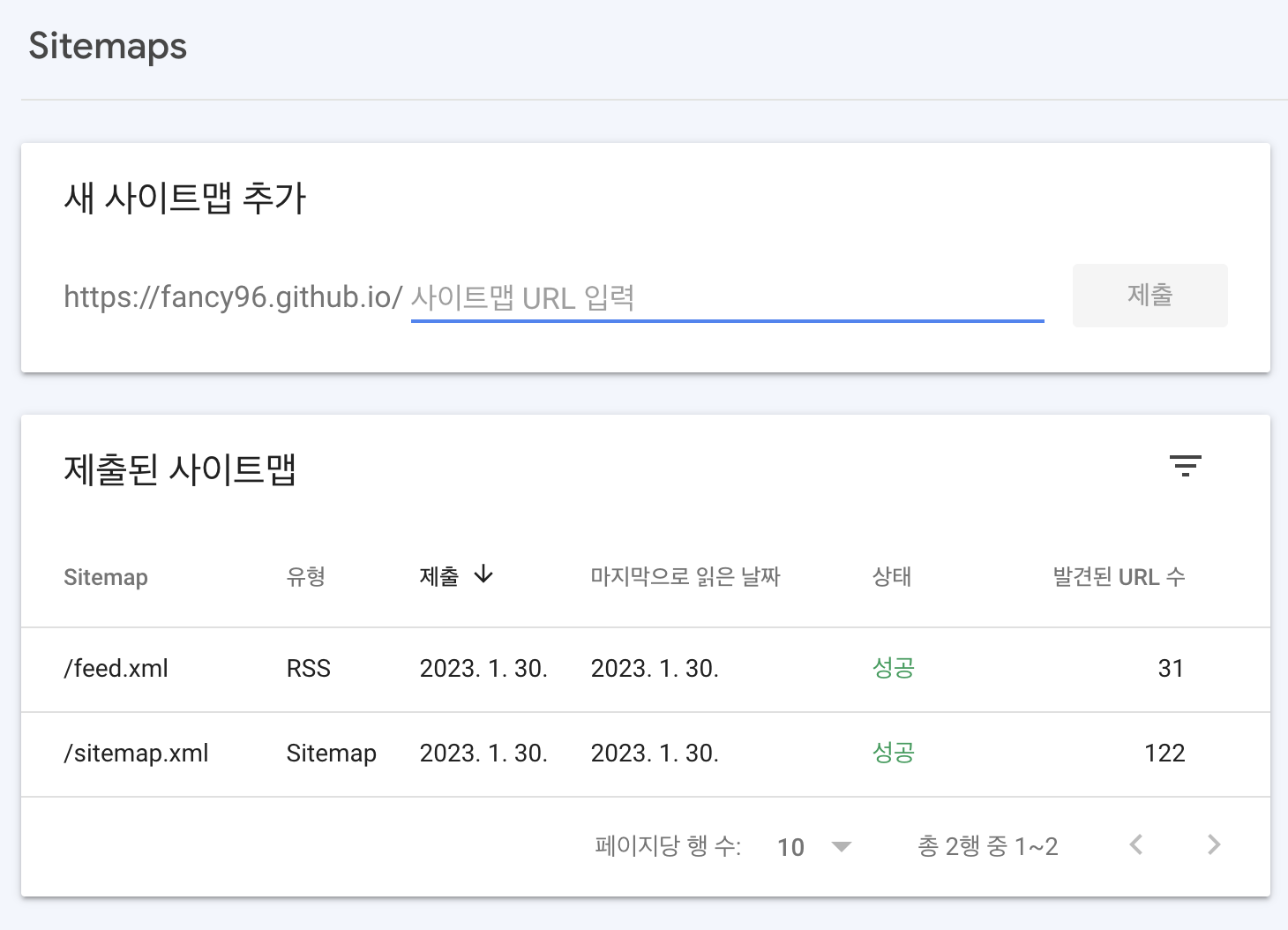
Reference
-
String 특징과 String 클래스의 주요 메소드
String의 생성과 특징
-
String 클래스는 문자열을 나타내며, 스트링 리터럴은 String 객체로 처리된다.
-
String 객체는 다음과 같이 생성할 수 있다.
String str1 = "home" // 스트링 리터럴로 스트링 객체 생성 char data[] = {'h', 'o', 'm', 'e'}; String str2 = new String(data); String str2 = new String("home"); // str2과 str3은 모두 "home" 문자열스트링 리터럴과 new String()
- 스트링 리터럴과 new String()으로 생성된 스트링은 서로 다르게 관리된다.
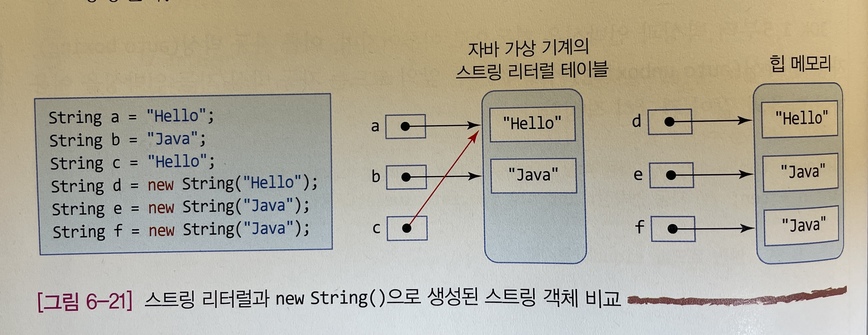
-
스트링 리터럴은 자바 내부에서 리터럴 테이블로 특별히 관리하여, 동일한 리터럴은 공유시킨다. -
그러나
new String()에 의해 생성된 스트링은Heap 메모리에 별도로 생성한다. -
리터럴을 공유시키는 이유는 스트링 생성에 대한 실행 시간을 줄이기 위해서이다.
스트링 객체는 수정이 불가능하다.
-
스트링 리터럴, new String()으로 생성했던 스트링 객체는 수정이 불가능하다.
-
그러므로 스트링 리터럴을 공유해도 한번 만들어진 스트링은 고칠 수 없기 때문에 문제가 발생하지 않는다.
String 활용
스트링 비교, equals()와 compareTo()
-
스트링 비교에서 == 연산자를 절대 사용해서는 안되며, 대신 String 클래스의 equals() 메소드를 사용해야 한다.
-
equals() 메소드는 스트링이 같으면 true, 아니면 false를 리턴한다.
String java = "Java"; if(java.equals("Java")) // true-
String 클래스의 compare() 메소드를 사용하면 같은지, 큰지, 작은지를 모두 판단할 수 있다.
-
compareTo(String 비교대상)메소드는 현재 스트링과 비교대상 스트링을 사전 순서로 비교하여 같으면 0, 비교대상보다 작으면 -1, 비교대상보다 크면 1을 반환한다.
공백 제거, trim()
-
파일로부터 스트링을 입력받을 때, 스트링 앞뒤에 공백이 끼는 경우가 있다.
-
trim()은 스트링 앞뒤에 있는 공백 문자를 제거한 스트링을 리턴한다.
String a = " Hello nice to meet you\t"; String b = a.trim(); // b = "Hellonicetomeetyou". 스페이스와 `\t` 제거됨String 클래스의 주요 메소드
char charAt(int index)- index 인덱스에 있는 문자 값 리턴- 문자열 중에서 한 글자만 선택하는 경우 사용한다.
String toLowerCase()- 소문자로 변경한 스트링 리턴 /String toUpperCase()- 대문자로 변경한 스트링 리턴- 대소문자가 섞여있는 문자열을 소문자로 변환할 때 사용한다.
int length()- 스트링의 길이(문자 개수) 리턴- 참고로, 배열로 선언된 String은
length로 사용한다.
예시) 문자열 내 p와 y의 개수 (갯수가 같으면 true, 다르면 false 리턴)
// 프로그래머스 Lv1 class Solution { boolean solution(String s) { s = s.toLowerCase(); int count = 0; for (int i = 0; i < s.length(); i++) { if (s.charAt(i) == 'p') count++; else if (s.charAt(i) == 'y') count--; } if (count == 0) return true; else return false; } }String [] split(String regex)- 정규식 regex에 일치하는 부분을 중심으로 스트링을 분리하고 분리된 스트링을 배열에 저장하여 리턴- 문자열을 배열로 전환할 때 사용한다.
예시)
class Solution { boolean solution(String s) { String [] arr = s.toLowerCase().split(""); }boolean contains(CharSequence s)- s에 지정된 문자들을 포함하고 있으면 true 리턴String replace(CharSequence target, CharSequence replacement)- target이 지정하는 일련의 문자들을 replacement가 지정하는 문자들로 변경한 스트링 리턴String subString(int beginIndex)- beginIndex 인텍스부터 시작하는 서브 스트링 리턴- 문자열을 원하는 위치에서 잘라야 하는 경우에 쓰이는 메소드이다.
예시)
String str = "0123456789"; str.substring(5); // 결과 : 56789- index 값이 5인 위치 이후 값을 가져오라고 했기 때문에 56789를 리턴하게 된다.
String subString(int beginIndex, int endIndex)- beginIndex 부터 endIndex 전까지 서브 스트링 리턴예시)
String str = "123456789"; str.substring(5,10); // 결과 :6789예시) 자릿수 더하기 - 자연수 N이 주어지면, N의 각 자릿수의 합을 구해서 return하는 solution 함수
// 프로그래머스 Lv1 public class Solution { public int solution(int n) { int answer = 0; String s = Integer.toString(n); //int n을 String으로 변환 for(int i=0; i<s.length(); i++){ answer += Integer.parseInt(s.substring(i, i+1)); } return answer; } }String concat(String str)- str 스트링을 현재 스트링 뒤에 덧붙인 스트링 리턴예시)
a = a.concat(b); // 문자열 연결 (a = "Hello", b = "friends") => "Hellow friends"String trim()- 스트링 앞뒤의 공백 문자들을 제거한 스트링 리턴Reference
- 책 - 명품 자바 에센셜
-
-
SOP와 CORS란 무엇인가?
- 출처(Origin)의 정의
- SOP(Same-Origin-Policy, 동일 출처 정책)란 ?
- CORS(Cross-Origin-Resource Sharing, 교차 출처 리소스 공유)가 나오게 된 배경
- CORS(Cross-Origin-Resource Sharing, 교차 출처 리소스 공유)란?
- 참고
출처(Origin)의 정의
-
SOP와 CORS에 대하여 이야기 하기 전에, 두 개념과 관련된 출처(Origin)에 대해 짚고 넘어가자.
-
출처는 프로토콜(Protocol or Scheme), 호스트(Host), 포트(Port)로 구성되어 있고 모두 같아야 동일한 출처라고 말한다.
-
https://www.domain.com:443에서https://는 프로토콜,www.domain.com은 호스트,:443은 포트에 해당한다.
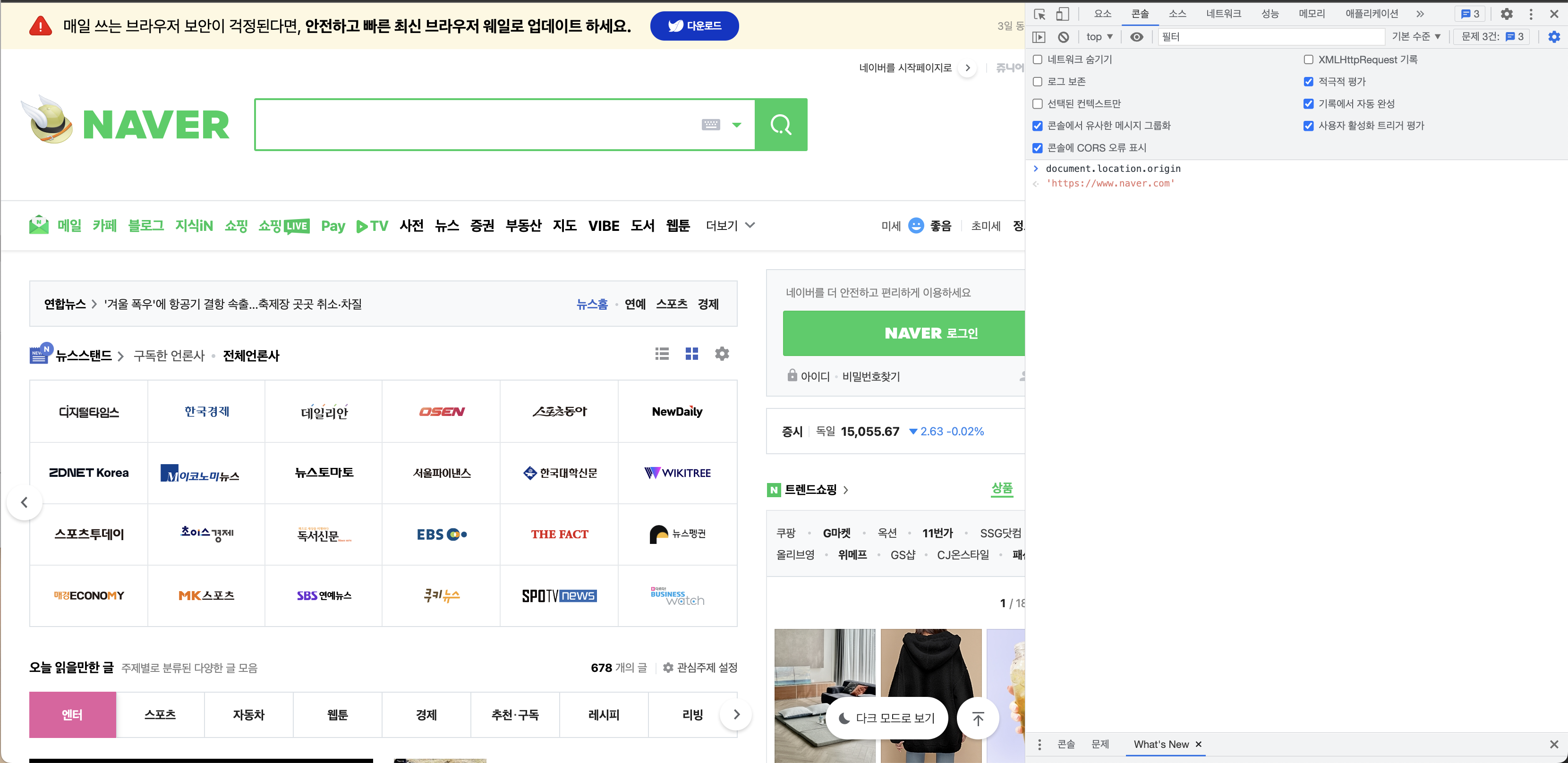
- 네이버에서 f12눌러서(Mac은 fn+12) Console 창에서 다음과 같이
document.location.origin이라고 치면 해당 출처를 확인할 수 있다.
동일 출처 예시
-
https://www.starbucks.co.kr과http://www.starbucks.co.kr/은 프로토콜이 다르므로 동일 출처가 아니다. -
https://www.apple.com/kr/과https://www.apple.com/kr/iphone/는 경로만 다르므로 동일 출처이다. -
https://www.youtube.com/과https://www.youtube.com/:443은 https의 기본 포트가 443이므로 동일 출처이다.
SOP(Same-Origin-Policy, 동일 출처 정책)란 ?
-
SOP는 어떤 출처(origin)에서 불러온 문서(document)나 스크립트(script)가 다른 출처에서 가져온 리소스와 상호작용하는 것을 제한하는 중요한 보안 방식이다.
-
쉽게 말해, 기본적으로 출처가 다를 경우 서로 간의 문서나 스크립트에 접근을 할 수가 없고 극히 제한적인 객체에만 접근이 가능하다.
-
동일한 출처 정책을 구현하는 브라우저는 한 출처에서 제공되는 웹 사이트 스크립트가
XMLHttpsRequesst또는FetchAPI와 같은 메서드를 사용하여 다른 출처에 요청하는 것을 제한한다.
CORS(Cross-Origin-Resource Sharing, 교차 출처 리소스 공유)가 나오게 된 배경
-
현재는 프론트엔드 레이어와 API 서버 레이어를 따로 구성하는 경우가 많다. 웹 프론트엔드 사이트 따로, 서버 사이트 따로 둔다는 의미이다.
-
이런 경우에 보통 웹 프론트엔드에서 다른 도메인에 위치한 API 서버로 요청을 넣아야 하는 상황이 생긴다.
-
하지만 과거에는 이런 기능이 당연하게 제공하지 않았다.
-
사실 원래는 도메인이 다르면 요청을 주고 받을 수 없게 하려는게
웹 브라우저의 기본 정책이였다. -
과거) 이전에 웹사이트를 만든다고 하면 이런 구조였다.
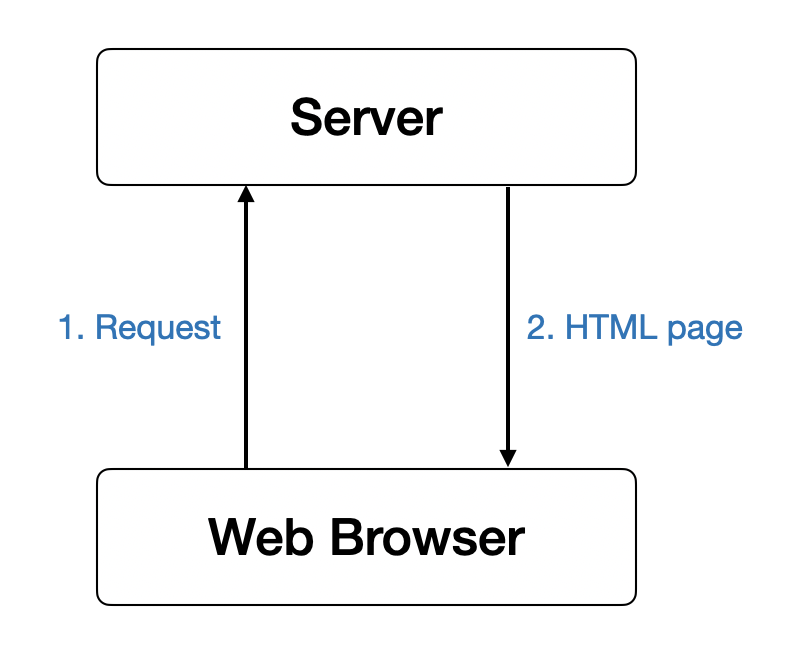
-
유저가 웹 브라우저 주소칭에 주소값을 입력을 하면 해당하는 서버로 요청이 보내진다.
-
그러면 서버에서는 응답을 할 때 HTML 페이지를 반환한다.
-
즉, 하나의 서버에서 비즈니스 로직과 HTML 페이지 빌드를 같이 하는게 일반적이였다.
-
왜 예전에는 같은 도메인에서 요청을 주고 받아야 했냐고 묻는 다면, 개인정보 유출, 피싱 사이트와 같이 보안상 악의적인 행동을 하는 걸로 의심을 하였기 때문이다.
-
하지만, 시간이 지남에 따라 웹사이트에서 할 수 있는 일이 많아졌다.
-
단순히 문서작성 뿐만 아니라 무언가 어플리케이션을 만들기 시작했고 그러한 상황들이 많아지다 보니, 기존 웹브라우저 보안 정책에 대해 불편한 점들이 조금씩 생기기 시작했다.
-
그래서 결국엔 웹브라우저에서 공식적인 루트를 열어준 것이 바로
CORS다.
CORS(Cross-Origin-Resource Sharing, 교차 출처 리소스 공유)란?
-
타사 API에 액세스해야 하는 필요성을 해결하기 위해 CORS 정책은 한 출처에서 제공하는 스크립트가 다른 출처의 리소스를 요청할 수 있는 방법을 결정한다.
-
쉽게 말해, 서로 다른 도메인간에 자원을 공유하는 것을 의미한다.
-
CORS 정책은 요청/응답 상호 작용에 포함되어야 하는 특정 HTTP 헤더를 정의한다.
-
서버가 요청을 허용할 출처를 통신할 수 있도록 한다.
-
그런 다음 브라우저는 스크립트가 응답에 액세스하는 것을 허용하거나 금지하여 이를 실행한다.
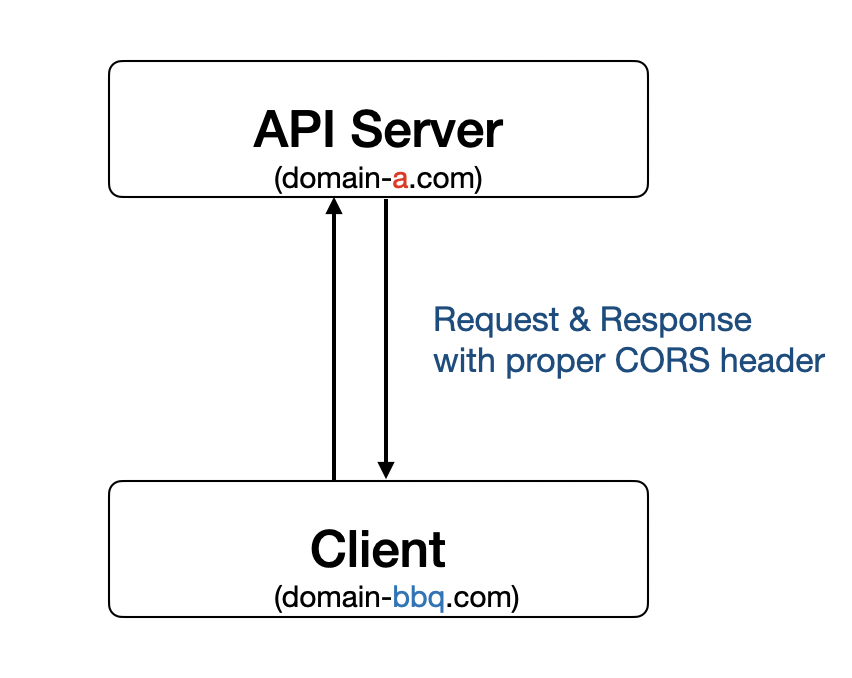
-
일반적으로 이 CORS 세팅을 직접 할 일은 거의 없고, 웹 프론트엔드에서 요청 넣을 때 CORS 옵션만 넣어주면 요청 헤더까지 알아서 다 넣어준다.
-
웹 서버에서도 마찬가지로, 간단한 옵션을 통해서 CORS를 켜고 끌 수 있게 구성을 해두었다.
-
다시 말해, 프론트의 경우에는 Request Header에 CORS 관련 옵션을 넣어주고, 서버의 경우에는 Response Header에 프론트의 요청을 허용한다는 내용을 넣어주면 된다.
-
조금 특별한 점이 있다면, 다음 그림처럼 HTTP OPTION 메소드이다.
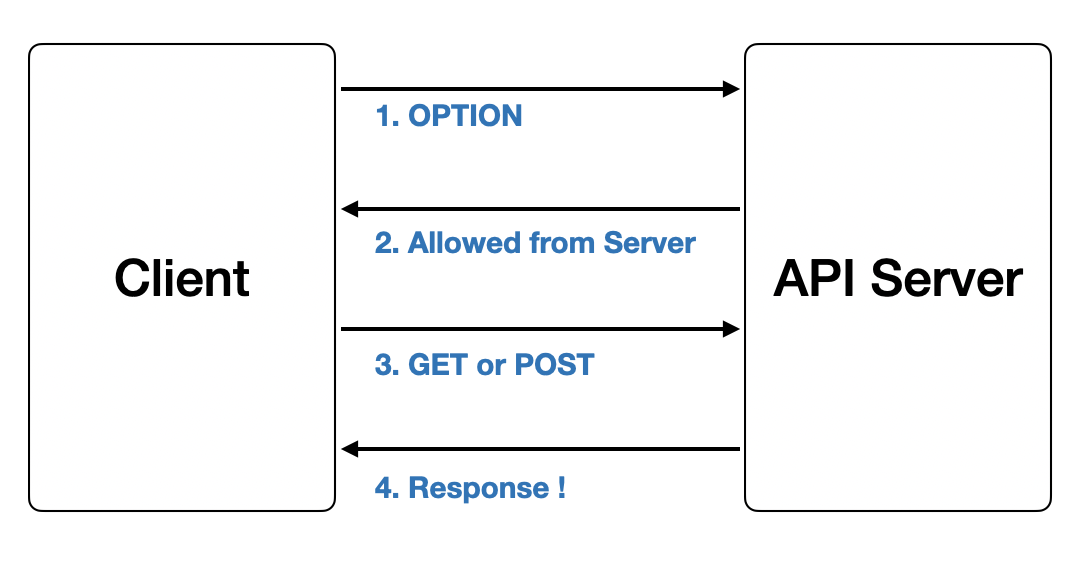
-
크로스 도메인 요청을 보내는 작업은
2번보내게 된다(Client -> Server) -
그래서 서버에서 웹브라우저로부터 크로스 도메인 요청을 받으려면 동일한 라우터에 대해서 OPTION 메소드 처리를 따로 하도록 작업을 해주어야 한다.
-
보통은 서버 라이브러리에서 간편하게 알아서 해준다.
-
위의 예시들을 아래에 조금 더 자세하게 살펴보겠다.
-
원본 간 요청의 경우 브라우저에서 처리하는 세 가지 유형이 있다.
1. 간단한 요청(Simple Requests)
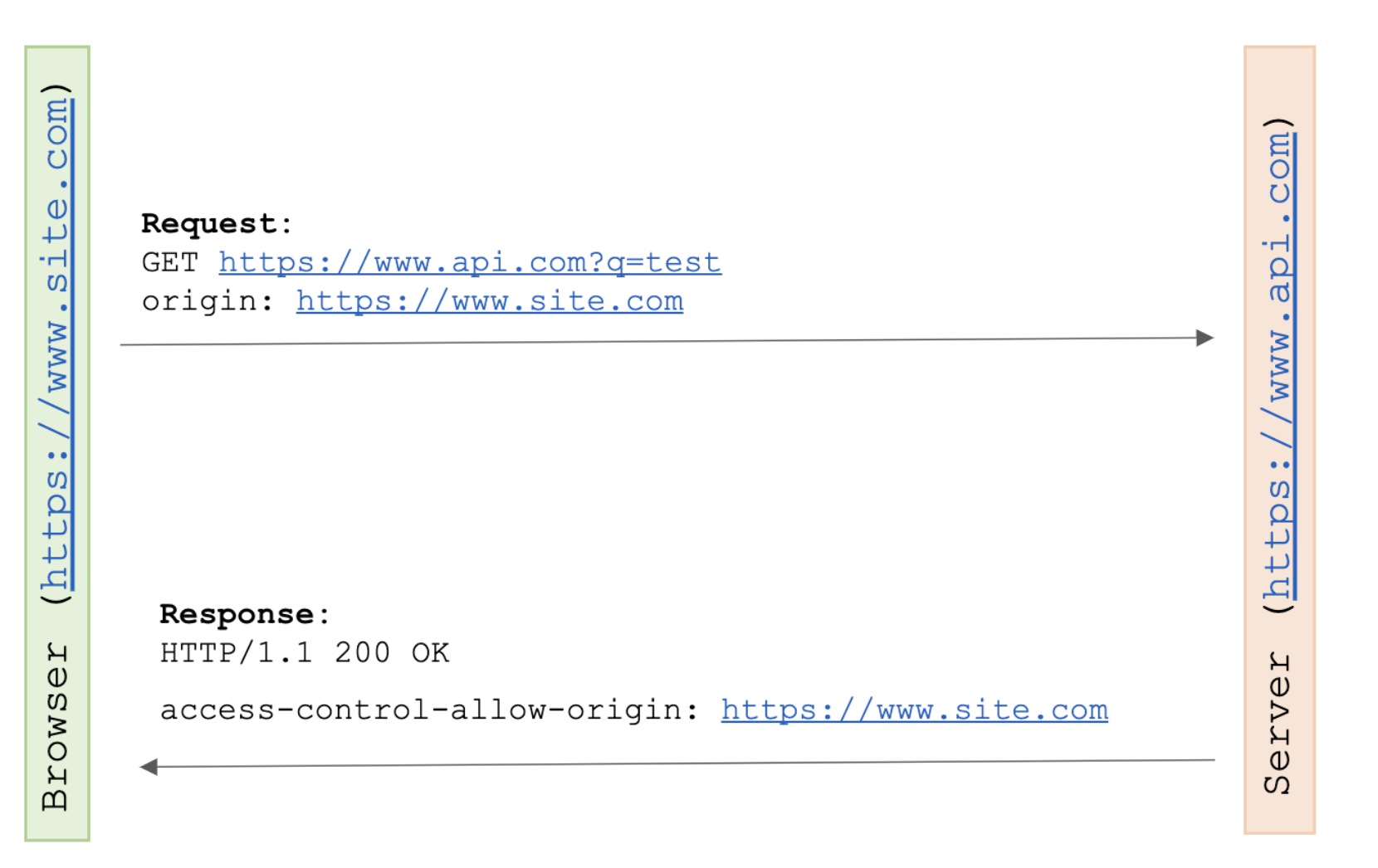
-
이미지에 있는 내용을 설명하면 이렇다.
-
먼저 브라우저는 서버에 원본을 식별하는 헤더를 포함시켜 요청을 보낸다.
-
서버는 요청된 데이터로 응답하고
https://www.site.com으로 설정된 access-control-allow-origin 헤더도 포함한다. -
브라우저는 requestHandler 메서드가 응답 데이터에 액세스 하도록 허용하여 이를 실행한다.
-
access-control-allow-origin 헤더는 서버가 허용할 요청을 표시하는 데 사용할 수 있는 기본 CORS 헤더 중 하나이다.
-
모든 곳에서 CORS를 허용하기 위해서는 모두를 의미하는 *를 입력하면 된다.
-
위의 이미지에서는 특정 출처에 대한 액세스를 허용하도록 브라우저에게 알리는 단일 출처이다.
- Example - (If 특정 출처에 대한 액세스 허용) Access-Control-Allow-Origin: https://www.site.com (If 모든 출처에 대한 액세스 허용) Access-Control-Allow-Origin: *-
서버가 access-control-allow-origin 헤더로 응답하지 않거나 헤더 값이 요청 원본과 일치하지 않는 도메인인 경우 브라우저는 응답이 스크립트로 다시 전달되는 것을 방지한다.
-
단순 요청은 다음을 충족하는 요청이다.
-
GET,HEAD또는POST요청을 허용한다. -
Accept,Accept-Language,Content-Langauage,Content-Type와 같은 User-Agent 헤더 또는 CORS Safelisted 헤더만 전송한다. -
ReadableStream개체를 사용하지 않는다. -
XMLHttpRequest.upload에 연결된 이벤트 리스너가 없다
-
2. 프리플라이트 요청(Preflighted requests)
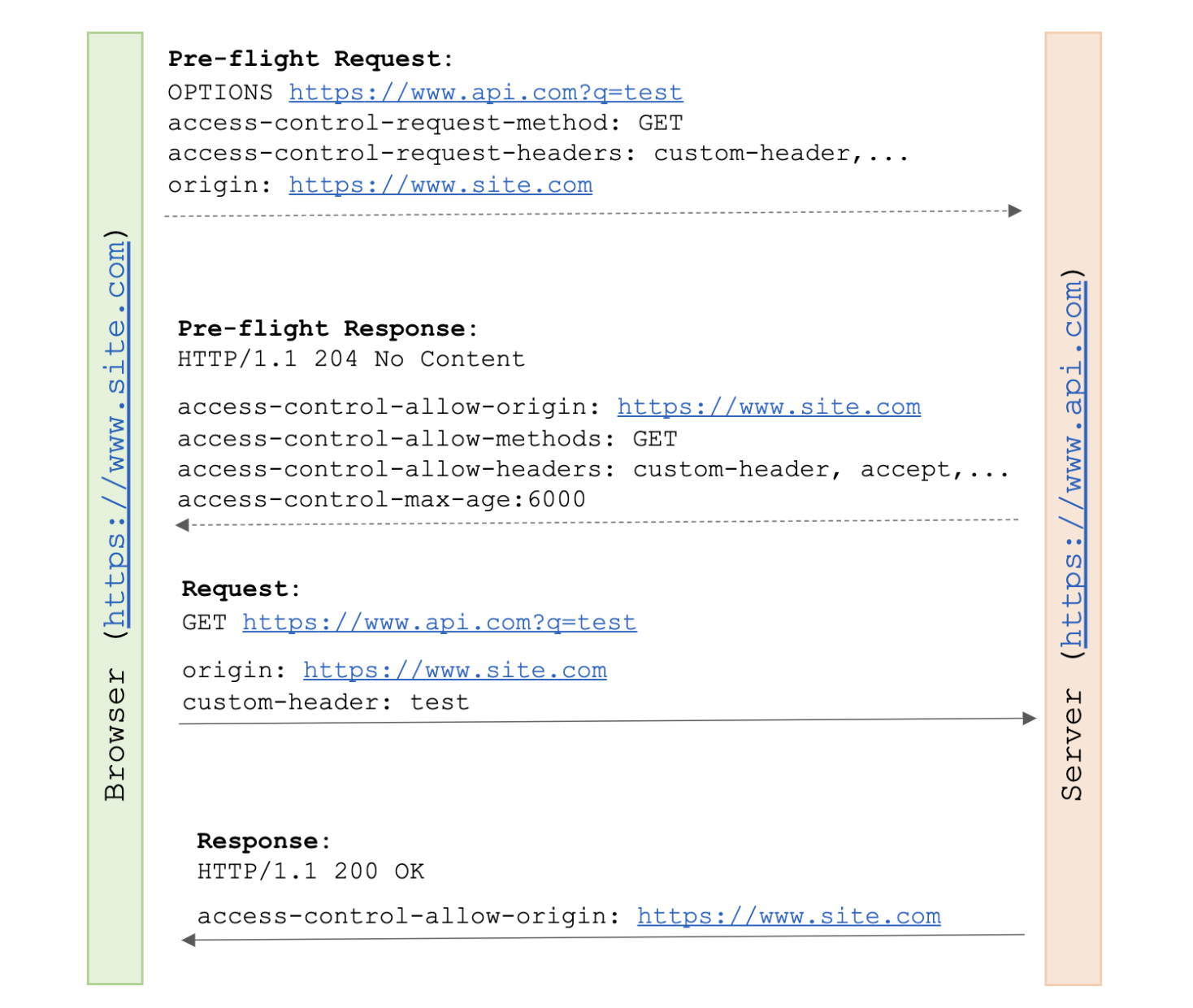
-
실제 요청을 보내기 전에 브라우저는 이러한 유형의 요청을 허용하는지 서버에 확인하는 요청이다.
-
실행 전 요청은 다음 헤더를 포함하는 OPTIONS 요청이다.
- origin : 서버에 요청이 오는 출처를 알려준다. - access-control-request-method : 요청이 구현하는 HTTP 메서드를 서버에 알려준다. - access-control-request-headers : 요청이 포함된 헤더를 서버에 알려준다.- 이에 대한 응답으로 서버는 다음 헤더로 응답하여 이 출처에서 이러한 종류의 요청을 수락할지 여부를 결정할 수 있다.
- access-control-allow-origin – 서버가 허용할 원본 - access-control-allow-methods – 서버에서 허용할 쉼표로 구분된 메서드 목록 - access-control-allow-headers – 서버에서 허용하는 쉼표로 구분된 헤더 목록 - access-control-max-age – 실행 전 요청에 대한 응답을 캐시하는 시간(초)을 브라우저에 알려준다.왜 Preflight 요청을 해야할까?
-
프리플라이트 요청을 통해 서버는 요청이 실행되기 전에 검사하고 허용 여부를 표시할 기회를 얻을 수 있기 때문이다.
-
그리고 서버가 다른 출처에서 허용하지 않는 특정 요청을 차단함으로써 서버를 보호하는데 도움을 준다.
-
이 외에도 서버는 개발될 때 허용하는 요청 및 헤더의 종류를 변경할 수 있다.
3. 인증된 요청(Credentialed Requests)
-
인증 관련 헤더를 포함할 때 사용하는 요청이다.
-
자격증명은 쿠키, 인증 헤더 또는 TLS 클라이언트 인증서일 수 있다.
-
클라이언트측에서 자격증명(
credentials)이 포함되어있고 서버에서Access-Control-Allow-Credentials가 true로 응답해야만 허용한다. -
이때, 서버는 반드시 “*” 와일드카드를 지정하는 대신
Access-Control-Allow-Origin헤더 값에 출처를 지정해야 합니다.
참고
-
[Programmers] 12943. 콜라츠 추측
성능 요약
메모리: 77.5 MB, 시간: 0.02 ms
구분
코딩테스트 연습 > 연습문제
Answer Code1(23.01.10)
class Solution { public int solution(long num) { int answer = 0; while(num != 1) { if(num % 2 == 0) { num /= 2; }else { num = (num*3) + 1; } answer++; if(answer == 500) { answer = -1; break; } } return answer; } }
-
[Programmers] 12919. 서울에서 김서방 찾기
성능 요약
메모리: 75.2 MB, 시간: 11.50 ms
구분
코딩테스트 연습 > 연습문제
Answer Code1(23.01.10)
class Solution { public String solution(String[] seoul) { String answer = ""; for(int i = 0; i < seoul.length; i++) { if(seoul[i].equals("Kim")) { answer = "김서방은 " + i + "에 있다"; break; } } return answer; } }
- 외부 시스템과의 연동 시 발생하는 장애를 격리하기 위해 서킷 브레이커 적용하기
- Spring Boot, Kotlin 함수형으로 안전하게 서킷 브레이커 구현하기
- 테스트에 대한 전략과 고찰
- '요즘 당근 AI 개발' 책 후기
- '제미니의 개발실무 - 커머스 백엔드 기본편' 강의 후기
- Spring Boot에서 Sentry를 이용한 에러 추적 시스템 개선하기
- '도메인 주도 개발 시작하기' 책 후기
- 토스 SLASH 24 Server '분산 트랜잭션과 지속 가능한 마이그레이션 전략' 정리
- 토스 SLASH 22 Server '왜 은행은 무한스크롤이 안되나요' 정리
- [카프카 핵심 가이드] CHAPTER 5. 프로그램 내에서 코드로 카프카 관리하기: AdminClient를 활용한 토픽 및 컨슈머 그룹 관리
- DevHistory 3
- Java 10
- Spring 15
- SpringBoot 17
- JPA 13
- MySQL 3
- Flyway 1
- Kafka 7
- Technology 21
- GoodCode 7
- Side_Project 20
- Retrospective 4
- AlgorithmSkill 3
- LeetCode 2
- Algorithm 70
- SQL 9
- OS 14
- Database 8
- Network 7
- HTTP 7
- DataStructure 5
- Linux 4
- Woowacourse 4
- Git 9
- AssertJ 1
- IntelliJ 5
- Probability-Statistics 5
- Electronic-Finance 13
- Business-Statistics 13
- Competition 1
- Book 5
- Workout 7
- E.T.C 8